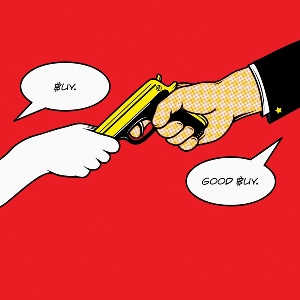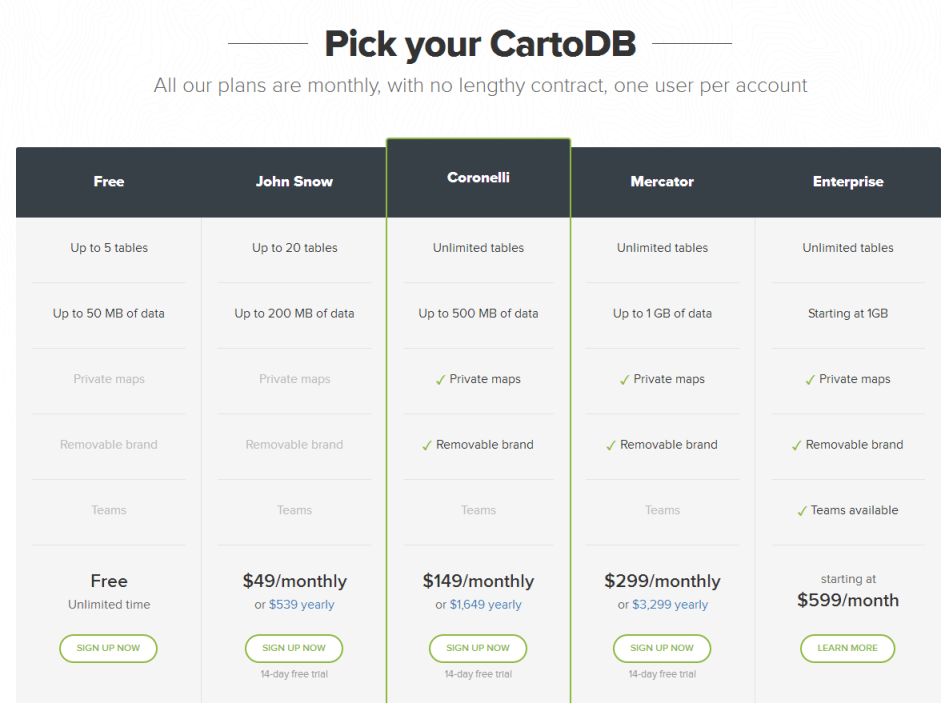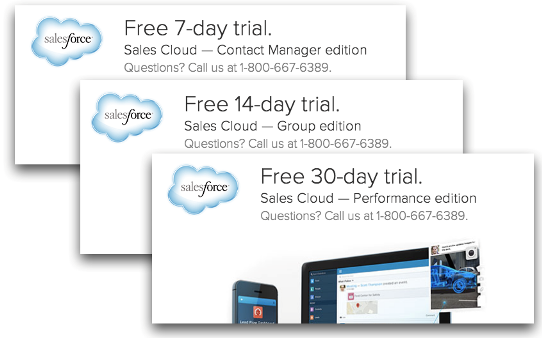Increasing website sales: how long should a free trial period be for a customer to pay?
 Suppose there is a company that has chosen paid tariffs and a free trial period for each of them, Free Trial, as a model for monetizing its cloud service. But how to choose its duration? What to build on when setting the test period? We recommend the article by Lincoln Murphy , where he, using the example of real customers, tells what you should think about when choosing the length of the trial period, what’s too dangerous a too short trial period, and why you shouldn’t refer service testing to the sales cycle. The article is written in the first person. What should be the Free Trial?
Suppose there is a company that has chosen paid tariffs and a free trial period for each of them, Free Trial, as a model for monetizing its cloud service. But how to choose its duration? What to build on when setting the test period? We recommend the article by Lincoln Murphy , where he, using the example of real customers, tells what you should think about when choosing the length of the trial period, what’s too dangerous a too short trial period, and why you shouldn’t refer service testing to the sales cycle. The article is written in the first person. What should be the Free Trial?There is one thing that no one recognizes: the duration of the free period of using the cloud service is a marketing ploy.
Such a length of the Free Trial period, which would be effective for any SaaS company of any category in any market segment, does not exist. Such phrases do not fit into the classic format of my articles, because I usually say “always do this” or “never do that”, but in this case everything is different. The only valid free trial period is the one that best fits the current situation.
For example, I somehow helped through Clarity of one company, and the next day they set a free week-long trial period. In the context of their situation - with the demand, the market, customers, value proposition, the rate at which this offer was rated by customers, and so on. - 7 days seemed like the most sensible choice. Yes, they had a lot of problems, but the length of the trial period was not one of them.
')
There is something that I always advise you to do before building a wall from the credit card data entry form between the service and potential clients, develop a pricing strategy and think over the Free Trial format, including reflecting on its duration.
This article will help you to avoid accidents when choosing the duration of the free test period, as well as to understand how such a method is bad. It may be clear to you why you should try to understand customers, the market, expectations, and how your value proposition and competitors influence the opinion of your potential customers about the length of the free trial period you have chosen for your product.
So.
Short free trial period scares customers away
If the test period is too short, you risk that potential customers, in the first place, will not want to register - and this is definitely for you.
I always say that we need to come up with more options that would motivate users to register, rather than scare them away from this targeted action.
As I already wrote, the duration of Free Trial is just a marketing ploy aimed at attracting customers, and if, according to customers, the trial period is too short to evaluate the effectiveness of your service, they simply do not want to start using it.
When you think about what length of trial period to install, remember that “too short” is a relative concept and depends on the client.
Remember, people are always busy and absent-minded. If they decide that you do not want to give them enough time to evaluate the product, they will pass it. They will tell themselves - and maybe even you - that they will return later, when they have more time, or when the time comes. But they will not return. You will lose these customers without even trying to keep them.
You should not attribute the time of service testing by a potential client to the sales cycle
The period of free testing in your calculations should preferably be separated from the work on sales, including it is better to consider the conversion of the user into a paying customer separately. And also do not focus on the duration of the trial period when planning the length of the sales cycle.
This means that if you are trying to determine the length of your sales cycle, based on your current length of the trial period, you are doing everything wrong. Believe me, this way of perceiving a free trial period is contrary to elementary common sense. At least, I do not know successful cloud services using this model.
My (not yet refuted) hypothesis of a free trial period for cloud service
The hypothesis that underlies my submission, which is checked again and again by time and my clients and does not find any refutation, is very simple: the duration of your promotional period for potential clients should be long enough for them to be able to appreciate your proposal. .
Too often, potential customers leave after a too short trial period, because they did not have enough time to “test”, “try”, “touch” your product.
Well, and how then to understand that your test period keeps (or will it do in a short time) potential customers from registering?
- Talk to customers to understand how their product evaluation process takes place.
- Talk to potential customers on the same topic.
- Talk to competitors' customers to find out: maybe they didn’t try your product because of the length of the trial period?
- Talk to consumers of related products with whom you have a common target audience, one price level, the same sales cycle, and a similar process to understand the expectations from the trial periods in your segment as a whole.
- Perform a / b testing calls to try the 14- and 30-day free trial.
- Analyze, monitor and optimize the site visitors -> registration metric.
- Imagine, think of ways to determine the optimal length of the trial period.

Myth: a short trial period filters users
I don’t know about you, but I want as many users as possible to subscribe to my product so that I can convert more customers, even if the conversion rate drops, but the number of new customers grows. Sometimes the conversion rate may not be as significant a metric.
I know all the arguments against this argument. "If we offer a longer trial period, we will attract users who are not serious about our product, and they are not converted into customers."
My experience says that if during the test period we have recruited many users who do not convert to customers who are not attracted by the product, this is not due to the lack of pressure for free testing, but rather for some other reason. For example, because of how we chose the target audience, how we brought to it the value proposition, what partners we have, and so on.
The reality is that people (marketers, startups, executives, investors and other members of the human race) tend to consider external factors to be the cause of their problems, but not their own shortcomings.
The process of adapting your product can be exciting, elaborated to the smallest detail, especially if you have developed a product for a staid corporate market, you can create a furore with its unusualness. But if users don’t even try to register to try, because they don’t believe that they will have time to figure it out and evaluate the product in 3 or 7 days (maybe also because they don’t believe that in this segment of the corporate market such an amazing decision perhaps in principle) - you lose.
Of course, when they have already decided to try the product for free, you must work diligently to turn them into paying customers as soon as possible.
Bottom line: yes, the length of the free trial period is just a marketing ploy. Offer 30 days free trial? Fine! Get tense and make testers grow into customers in three days.
Take, for example, Constant Contact. The complex of their products operates on the basis of an e-mail marketing platform, and their audience initially selected small and medium businesses. They realized that their customers are very busy people, so they need as much as 60 days to try out Constant Contact.

But if you get acquainted with the ideas of the executive director of Constant Contact Gale Goodman about how you can quickly cause people to wow effect, it becomes clear that the 60-day free trial period is completely separate from the sales cycle in the internal understanding of this company.
The length of the free trial period of the cloud service is directly proportional to the complexity of the product.
You can even do what Salesforce.com did to use the length of the Free Trial to differentiate the cost of using different service packages.
They give 7 days of free trial for a package for $ 5, 14 days for $ 25 and 30 for $ 300.

The more complex the product, the longer you need to test it. Is it logical Is logical.
So what should be the duration of Free Trial?
From the client’s point of view: Long enough for the client to fully appreciate the product.
From the point of view of the company: As short as possible.
To understand what length is the right one for your product, you need to understand your customers, know the needs and expectations of the market, represent the train of thought of buyers, keep in mind which product you are squeezing out.
As soon as they decide to try, your task is to turn them into paying customers as quickly as possible, regardless of the length of the test period. If you have a 30-day Free Trial, this does not mean that no one will start paying until on the 31st day the service reports that the trial period has expired (although, alas, this is usually the case). They may think that they have 30 days, but you have to look at it from such an angle, as if you only have 3 days to get the USE of the product to the fullest and turn testers into paid customers in the first week.
You have to achieve this by speeding up the adaptation process to quickly get a wow effect, letting them understand the full value of your product AS FAST AS POSSIBLE , and then offer to buy it at a price adequate to the one they used to pay for solving relevant problems.
So I helped one SaaS company to reduce the average conversion time for paying customers with their 30-day free test period from 42 days (yes, 12 days thinking after the end of the test period) to 3 days. And by using creative discounts, I helped them raise the average value of one subscribing client by 33%.
Hope this is of little use to you.
Source: https://habr.com/ru/post/235819/
All Articles